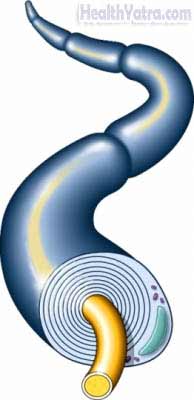X-linked Adrenoleukodystrophy Treatment in India
X-linked adrenoleukodystrophy (ALD) is a rare inherited genetic disorder. There have been 34 subtypes of ALD described. X-linked ALD is the most common category. ALD results in degeneration of:
- Myelin sheath—fatty insulation covering on nerve fibers in the brain
- Adrenal gland and surrounding adrenal cortex—produces vital hormones

There are six subtypes of X-linked ALD:
- Childhood cerebral ALD
- Adolescent ALD
- Adrenomyeloneuropathy
- Adult cerebral ALD
- Adrenal insufficiency-only
- Symptomatic heterozygotes
Causes
ALD is caused by an inherited defective gene.
In people with ALD, the body cannot properly break down fatty acids. This results in a build up of saturated fatty acids in the brain and the adrenal cortex. This causes damage of the myelin sheath in the brain and the adrenal gland.
Risk Factors
Factors that increase your chance for X-linked ALD include:
- Having a mother who carries the defective X-linked ALD gene
- Age: Childhood to young adult
- Sex: Male, although females may be affected
Symptoms
Symptoms can vary within the types of ALD.
X-linked ALD (Childhood Cerebral ALD)
This form is the most severe. It only affects boys. Symptoms usually begin between 2–10 years of age. About 35% of patients can have severe symptoms during the early phase. On average, death results in two years. Some patients may live a couple of decades.
Initial symptoms include:
- Behavioral changes
- Poor memory
As the disease progresses, more serious symptoms develop. These include:
- Vision loss
- Seizures
- Hearing loss
- Difficulty swallowing and speaking
- Difficulty with walking and coordination
- Vomiting
- Fatigue
- Increased pigmentation (“bronzing”) of the skin, due to adrenal hormone deficiency ( Addison’s disease)
- Progressive dementia
- Vegetative state or death
X-linked ALD (Adolescent Cerebral ALD)
This type is similar to the childhood type. In this type it begins around 11-21 years of age. The progression is usually slower.
Adrenomyeloneuropathy (AMN)
This is the most common form. Symptoms of AMN can present in the 20s. It progresses slowly. They can include:
- Weakness, clumsiness, weight loss, nausea
- Emotional disturbances or depression
- Motor/movement problems (eg, walking problems)
- Urinary problems or impotence
- Adrenal gland dysfunction
X-linked ALD (Adult Cerebral ALD)
With this type, symptoms usually do not appear until young adulthood (20s) or middle age (50s). It causes symptoms similar to schizophrenia and dementia. It usually progresses quickly. Death or a vegetative state can occur in 3-4 years.
Symptomatic Heterozygotes
This form is only seen in women. Symptoms may be mild or severe. It usually does not affect the adrenal gland function.
Diagnosis
The doctor will ask about symptoms and medical history. A physical exam will be done. The doctor may suspect ALD from its symptoms. To confirm the diagnosis your doctor may order:
- Blood tests—to look for increased amount of very long chain fatty acids
- Genetic testing—to look for gene mutations
- MRI scan of the brain —may be done to look for brain involvement
Treatment
There is no known cure for the brain damage of ALD. However, the adrenal deficiency can be treated with cortisone replacement. ALD often causes death within 10 years of the onset of symptoms.
Some therapies can help to manage the symptoms of ALD. There are also some experimental treatments.
Therapies to help manage the symptoms of ALD include:
- Physical therapy
- Psychological therapy
- Special education (for children)
Some treatments that are still be investigated that you may want to talk to your doctor about include:
- Bone marrow transplantation —this procedure may be most helpful when given early to boys with X-linked child-onset ALD
- Dietary therapy, which includes consumption of:
- A very low fat diet
- Lorenzo’s oil—dietary supplements of glycerol trioleate and glycerol trierucate (oleic and euric acid)
- Lovastatin —an anti-cholesterol medicine
- Medicines that affect interactions between DNA and other proteins
Prevention
There is no way to prevent ALD. If you have ALD or have a family history of the disorder, you can talk to a genetic counselor when deciding to have children.
Early recognition and treatment may prevent the development of clinical symptoms. This is especially true in young boys who are treated with Lorenzo’s oil. New technologies may soon allow early identification through newborn screening.
